Beersheva is now a thriving city of over 180,000 residents and has a large hospital, a big university, lots of modern shopping, and businesses. It is truly the capital of the Negev. It also has more grand master chess players per capital than almost any city in the world, but that is another story! (The Biblical Beersheva was several miles east of the current one. It was a smaller town with a well and mainly was a military encampment. We visited "tel" Beersheva last summer with Haim.)
We drove from Kibbutz Shoval to Beersheva along the old road from Gaza to Beersheva. It was not much more than a dirt path until the Turks built an extension of the railroad to go from Gaza to the new town of Beersheva in the 1880s. (The British finally paved the road in the 1920s or later.) The Turks were the driving force in establishing modern Beersheva as a strategic area for themselves. It occurred at about the same time as the first or second aliya, so a few Jewish families were there from the beginning.
Before we entered the north end of town, we passed the old airport that first the Turks and soon after the British used. It is called S'deh Teiman. We could still see semi-buried earth-covered shelters (with some concrete reinforcement) under which a Spitfire could be covered. During World War I, the German and Turks were alies. Teiman was a German airfield until Allenby and the British conquered the area.
As we entered town, on our right we saw what was left of the train station complex that the Turks built.
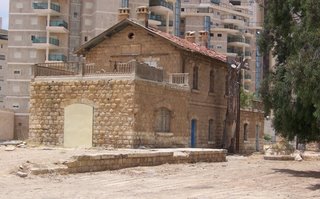
You can see how this one building now stands among many recently built high-rise condos. The city is planning to restore the RR station and turn it into a museum. This train station area was the hub of a huge transportation system during World War I. There were LOTS of freight cars, etc and was definitely a target of British bombing raids.
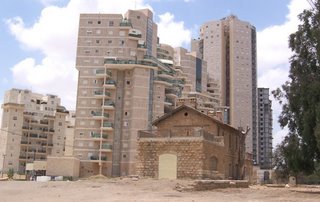
Haim told us that that area was huge, that there were trains coming and going with supplies and soldiers, especially during World War I. Jews, often new immigrants, were brought in from Tel Aviv to work on the train arena. One group was housed in a stationary box car. During World War I, there was a black out. However, it seems that the Jews in the box car, didn't follow the rules of the black out--they pushed the limits a bit like many Israelis do today. So one night when British planes flew overhead, the pilot and navigator saw a light where the train station was supposed to be, so they bombed it. Unfortunately, 8 Jews in the boxcar were killed. To add to it, the British pilot of the plane was a Jew and he had no idea that he was NOT bombing Turkish soldiers. (See a photo below for the grave of those 8 men.)
Haim drove about three or four blocks from the train station until he found the base of the huge water tower that used to supply the trains with water after they arrived at the station. The distance to it gave us an idea of how big this train station really was.
 As you can see, the base of the water town now exists among a kiddie play yard and many apartment buildings. In some ways it is a shame that this area has not been better preserved, though Haim says that there are plans to develop it better.
As you can see, the base of the water town now exists among a kiddie play yard and many apartment buildings. In some ways it is a shame that this area has not been better preserved, though Haim says that there are plans to develop it better.Just to the South of the remaining train station building, is a memorial to the Turkish soldiers that defended Beersheva against the British in World War I. It was erected by the city of Beersheva and the Turkish government. You can see Haim in the picture below. Just behind the memorial are the flags of Turkey and Israel.

 A closer look at the memorial
A closer look at the memorial At the bottom of the memorial is the writing to the left which is also in Turkish on another part. It says, "This monument is dedicated to the honorable Turkish army soldiers fallen at the Beersheva front for the sake of their country."
At the bottom of the memorial is the writing to the left which is also in Turkish on another part. It says, "This monument is dedicated to the honorable Turkish army soldiers fallen at the Beersheva front for the sake of their country." Lower on the memorial is the writing to the left, in Turkish and English: "Constructed on 20th October 2002 by the Republic of Turkey and Be'ersheva municipality in memory of 238 honorable Turkish army soldiers who lost their lives while service the Turkish state at the Be'er Sheva front between 1914 - 1918. It was interesting to me that the writing was in Turkish and English and not in Turkish and Hebrew.
Lower on the memorial is the writing to the left, in Turkish and English: "Constructed on 20th October 2002 by the Republic of Turkey and Be'ersheva municipality in memory of 238 honorable Turkish army soldiers who lost their lives while service the Turkish state at the Be'er Sheva front between 1914 - 1918. It was interesting to me that the writing was in Turkish and English and not in Turkish and Hebrew.A dry wreath lies at the bottom left which was brought recently by visiting Turks.
 The original plastic bag the wreath came in is under the wreath, and the ribbon across it says in Hebrew that it is from a mission from Turkey.
The original plastic bag the wreath came in is under the wreath, and the ribbon across it says in Hebrew that it is from a mission from Turkey.The Turks were interested in establishing Beersheva as a hub town and making it the capital of this desert area. By 1900 they could already forsee a war coming, so they were trying to expand their empire beforehand. The Young Turks came ito power in Turkey in 1908 and they wanted to develop this area for its strategic importance. It led to both the Suez Canal and the Red Sea. They also wanted more control and less anarchy in the area, so they decided to develop Beersheva as a center of the Negev, and they started by building the police station/government area.
They built a mosque, the police station and also a school for the sheiks' sons -- all of which were part of a large compound. The picture below shows the back of the mosque. To the right is the beginning of where the government area was. To the right and behind/below the picture about a half a block is the school.

 The mosque and garden from the front
The mosque and garden from the front The west (?) side of the police station and government area, still used today for official use
The west (?) side of the police station and government area, still used today for official use The school for the sheiks' sons
The school for the sheiks' sonsAs World War I approached, the British fought back and moved the line of control past Sinai. Unofficially the British ran Egypt and part of Sinai.
Then during the war, the British tried 3 times to take Gaza city. They sustained tremendous losses and each attempt failed. So they had to find another way of getting north.
Jewish and Beduin scouts helped them, and also the Arabs allied with Lawrence wanted to get the Turks out. The scouts found wells through the Sina desert and other desert areas and found water so that troops could be moved toward Beersheva. They then took Beersheva, surprising the Turks who thought they would still try to attack via the coast.
Then they needed to head north. Intelligence deceived the Turks into thinking that the British might make another attack at Gaza. Scouts even dropped saddlebags with maps and disinformation, saying that the British would go via the coast, so the Turks kept a lot of troops along the coast. There was also a possibility of the British heading north through the Jordan Valley, so the Turks stationed some troops there.
Instead, the British headed north through the hills of Hebron. It was difficult, but the Turks were completely fooled and there was not much of a battle along the way until they went through Wadi Ara and got to Megiddo. Even if the Turks had hadsome idea of the British movement a few days early, in those times it was quite difficult to move troops quickly.
Allenby eventually got quite close to Damascus but pulled back and let Lawrence and his Arab Legion's capture Damascus.
Near that same area, we saw the first "garden" planted here, the Allenby Garden.

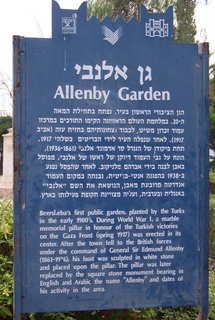
We then took a break from history and went to the Midrahov, a pedestrian walkway near the old Turkish government area. The Midrahov turns into a pedestrian mall on Fridays, with lots of vendors up and down each side for at least 3 blocks. There are people selling all kinds of items often found in stores, some with more unusual items such as Russian military medals and coins, and also artisans trying to sell their crafts. Also, we saw several tables of pirated CDs and DVDs.
 Start of the Midrahov, with water fountain on the left. Howard in hat with Haim and Shuna, our friends
Start of the Midrahov, with water fountain on the left. Howard in hat with Haim and Shuna, our friends A pottery stand
A pottery stand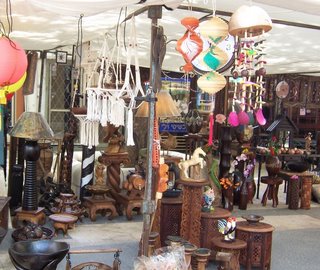 Wood products, mobiles, etc.
Wood products, mobiles, etc. Pirated DVDs for sale for 10 shekels each, or under $2.50--covers are in color and look like the real thing!!
Pirated DVDs for sale for 10 shekels each, or under $2.50--covers are in color and look like the real thing!!On the way to a lunch break, we drove by an old stone bridge that used to be part of a railroad extension to the south. The Turks built the extension for movement of troops and supplies when they hoped that they would take the Suez Canal. The bridge was built over the Nahal Beersheva which, during a heavier rainy season, has gushes of water going through the dry river bed. If you look carefully, you can see the stone bridge under the modern cement one.
 The modern one was built by Israel probably in the 60s or 70s to go to Oron, south of Dimona, where Israel has phosphate mines. We actually saw a freight train on its way to Oron, as we drove by, and I shot the picture above.
The modern one was built by Israel probably in the 60s or 70s to go to Oron, south of Dimona, where Israel has phosphate mines. We actually saw a freight train on its way to Oron, as we drove by, and I shot the picture above.We went to a restaurant in an open shopping mall for lunch, and the parking lot was super-full. Haim told us that some of the stores in this mall were open on Shabbat, which surprised me. When we left an hour later after lunch, more than two-thirds of the cars had disappeared. For many people, Friday is the first day of the weekend, so they use it for shopping and for fun outings before Shabbat begins.
After lunch, we went back to sightseeing....this time to cemeteries.
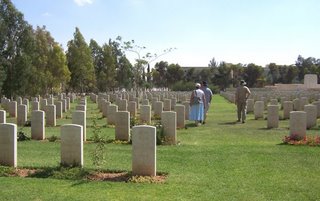 First we stopped at the cemetery where British soldiers were buried. During World War I, the British decided to bury their soldiers where they fell instead of trying to bring them back to their country, so the British government established (and still maintains) a cemetery here in Beersheva. Most British cemeteries have a center area with a cross and an upsidedown sword but due to sensitivity to the Muslims at that time, there is no upsidedown sword. The British cemeteries at Mt Scopus in Jerusalem and Ramleh are different than here. The families were allowed to have anything that wanted written on the stones (which are all the same size). They could put the symbols from their units or a cross. In this cemetery, there is at least one grave with a magen david (Jewish star). If you look carefully at the pictures that follow, you can see what they had written at the bottom.
First we stopped at the cemetery where British soldiers were buried. During World War I, the British decided to bury their soldiers where they fell instead of trying to bring them back to their country, so the British government established (and still maintains) a cemetery here in Beersheva. Most British cemeteries have a center area with a cross and an upsidedown sword but due to sensitivity to the Muslims at that time, there is no upsidedown sword. The British cemeteries at Mt Scopus in Jerusalem and Ramleh are different than here. The families were allowed to have anything that wanted written on the stones (which are all the same size). They could put the symbols from their units or a cross. In this cemetery, there is at least one grave with a magen david (Jewish star). If you look carefully at the pictures that follow, you can see what they had written at the bottom.
The British Embassy continues to maintain this cemetery. It is relatively small for such a cemetery, just about a block and a half by one block. Most of those buried here died between October and November of 1917. As you can see from above, modern (rather luxurious) condos have been built in the area of the cemeteries. Haim and his wife think that it is strange that people would want to live so close to the cemetery, but I mentioned that they might enjoy seeing the grass. Having grass in the cemetery is not normal practice in Israel as maintaining it is quite expensive because of the scarcity of water. (Haim says that the British government maintains many huge British cemeteries throughout Europe so this is not unusual.)
 Unknown soldier's grave...with cross-- on bottom "Known unto G-d"
Unknown soldier's grave...with cross-- on bottom "Known unto G-d" Grave of Jewish soldier....you can see that there are stones on top of this grave, the only one we saw with stones on top--a Jewish sign of having visited.
Grave of Jewish soldier....you can see that there are stones on top of this grave, the only one we saw with stones on top--a Jewish sign of having visited. Howard in front of Jewish soldier's grave so you can see the size of the graves.
Howard in front of Jewish soldier's grave so you can see the size of the graves.Also on one side of the cemetery, there was a special marker which you can see below. During the war, a number of British pilots fell from planes or crashed and died. The body of one was found by the Turks and buried in this spot with a gravestone on it, marking the spot. Later the British replaced the Turkish monument with this new monument below with the names of a total of 8 pilots lost in this area during World War I. It says on it, "This monument generously erected to one of them by their enemies was discovered and restored by their friends. January, 1918." To me it seemed amazing that the Turks were so sensitive.
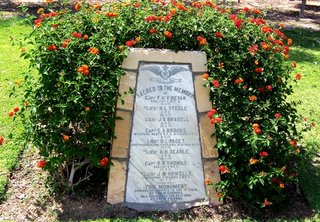
From this grassy British war cemetery, we went to the first Jewish cemetery in town, one that is still in use. As you can see from the pictures, there is no grass at this cemetery.
 Newer part of the Jewish cemetery with some recent graves and more "modern" Beersheva in the background.
Newer part of the Jewish cemetery with some recent graves and more "modern" Beersheva in the background.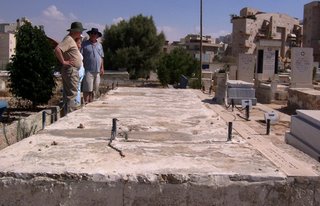 Unidentified grave of the 7 or 8 Jews who died in the train car in Beersheva during WWI when they didn't use blackout curtains--referred to above. The grave closest to front is that of a wife of one of the men whose grave was added years later.
Unidentified grave of the 7 or 8 Jews who died in the train car in Beersheva during WWI when they didn't use blackout curtains--referred to above. The grave closest to front is that of a wife of one of the men whose grave was added years later. A modern grave with a "window" in the back where there are 2 yarzeit (memorial) candles. Other graves also had such little nitches for these candles.
A modern grave with a "window" in the back where there are 2 yarzeit (memorial) candles. Other graves also had such little nitches for these candles.
I cannot end this blog without a picture of a pretty flower...this one (a pelargonium often used in window boxes) was taken in the flower box on the entry to the restaurant where we had lunch. It was small, about 2 inches in diameter, but really pretty. You can see it in relations to the Henna's Chick just above it. There were more Henna's Chicks, which were all much larger than we used to have when I lived in Spokane, WA.






No comments:
Post a Comment